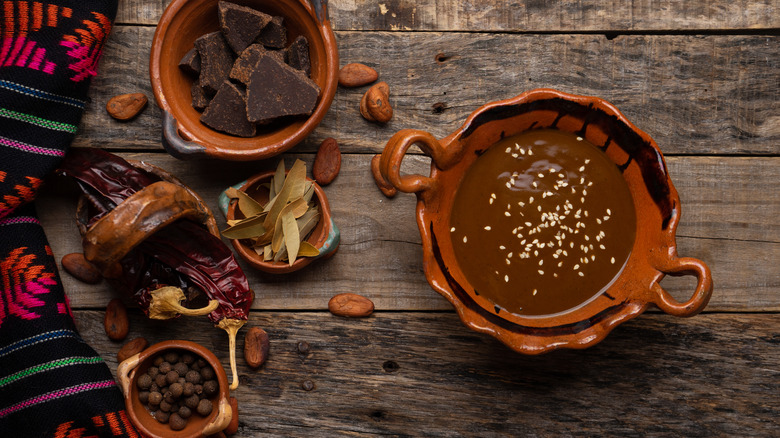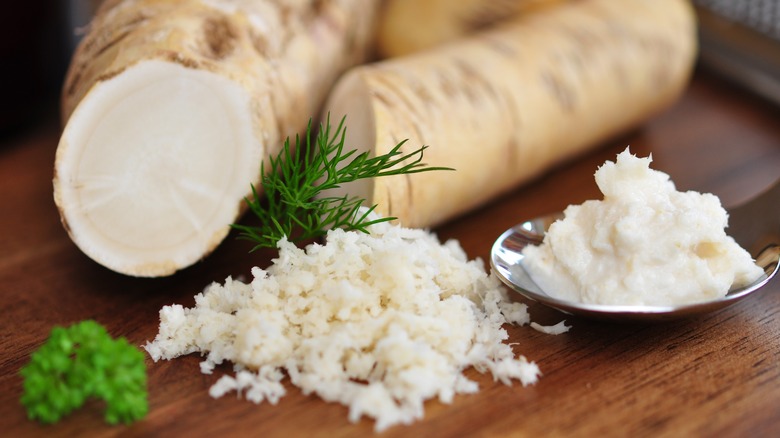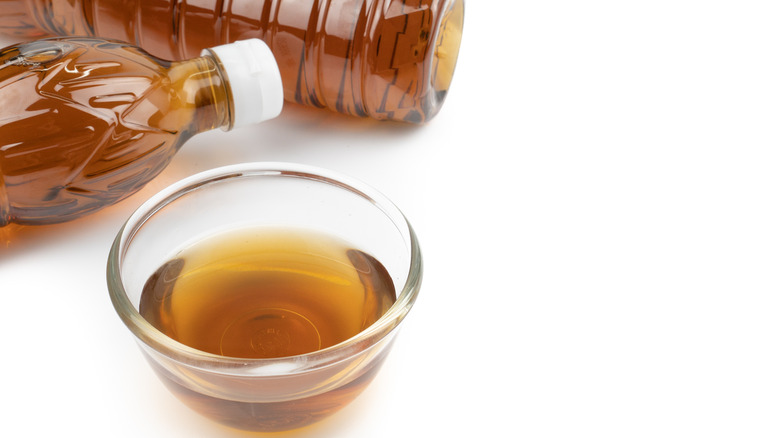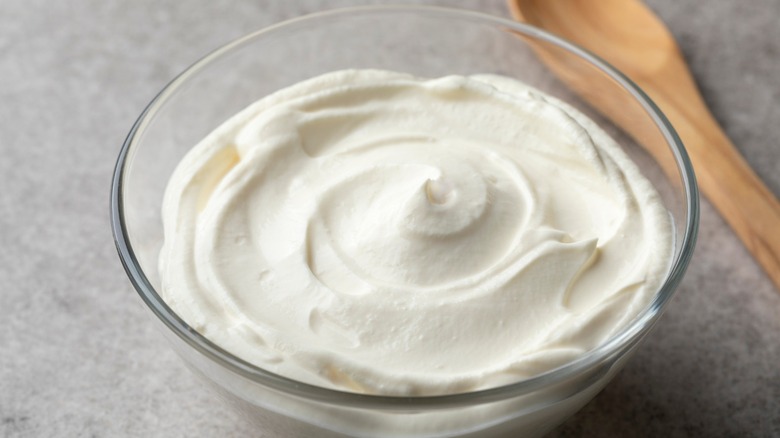12 Ways To Add Flavor To Homemade Steak Sauce
'Tis the season of holiday entertaining, which means dinner parties with friends, family, and a few picky eaters. One of the most surefire ways to impress a discerning guest is by searing up succulent steaks. While a perfectly cooked cut will show off your kitchen chops, you can elevate your main course to dinner party status with a sensational sauce.
It may be tempting to dump some plain steak sauce into a ramekin, but the flavor achieved with a homemade steak sauce can be pure magic. Making steak sauce is really very simple: You just need fat, acid, and aromatics like garlic for the basic building blocks. Other ingredients that bring sweetness, freshness, or umami are flavorful bonuses that provide extra depth. Looking for a dose of freshness? Try a chimichurri. Want a richer bite? Whip up a blue cheese sauce. If you can't decide, take a page from Rachael Ray's cookbook and serve two homemade sauces. Whichever route you choose, the most important tip for better homemade steak sauce is to let the mixture rest so that those flavors really meld together.
To help you out, we broke down the elements of some of the world's most popular steak sauces, from A.1. to béarnaise, to extract a list of secret ingredients that help the flavors of beautifully seared beef to shine. So the next time you find yourself in an entertaining rut, try using one of these under-the-radar additions to elevate the flavor of your homemade steak sauce.
Whole peppercorns
With a veritable rainbow of peppercorns from which to choose, adding flavor to your homemade steak sauce with a single spice has never been so simple. Found in hues of black, white, green, and even pink, freshly cracked peppercorns run the flavor gamut from, well, peppery to almost fruity.
So how do you know which pepper to pick for your steak sauce? When it comes to seasoning the steak itself, the most traditional option is a coating of black peppercorns, as seen in classic dishes like steak au poivre. However, sauces are a bit more delicate and don't always require the spicer, more pepper-forward taste of the blackberry. Instead, opt for the mild and tangy flavor of a green peppercorn sauce. Picked before fully ripened, green peppercorns haven't yet reached peak spice levels, resulting in a fresher, milder, more earthy taste. An added flavor boost comes from the brine-packed variety, which can take on a tart and tangy flavor that can further enhance your homemade steak sauce.
To coax the most flavor out of those little green beauties, you'll want to heat them in a little bit of fat before using them. This process is called blooming, and it's an essential tip for cooking with spices to achieve maximum potency. Heating the peppercorns causes them to release fat-soluble flavor compounds that then spread through the oil and distribute that tarty, tangy, peppery goodness through the whole dish.
Chocolate
Enjoy a mole-inspired twist on homemade steak sauce by adding dark chocolate into the mix. While not all mole recipes call for chocolate, it's a fairly classic addition to many mole negro recipes for its rich texture and slightly bitter notes. The word "bitter" may be a turn-off for many mole novices, but the mother sauce is beloved for the complexity it brings to simple dishes like a well-seared steak. The earthiness of the chili-spiced sauce helps to balance out the fatty richness of a ribeye, resulting in an indulgent bite your guests won't be able to get enough of.
When it comes to choosing your chocolate, it's all about personal preference — another reason to love ever-customizable mole. Dark chocolate alone varies immensely, ranging between 50% to 100% cacao. The less pure cacao in the mix, the sweeter the chocolate. However, if you want to go the super traditional route, try sourcing some Mexican chocolate. The unsweetened cacao mixture is blended with ground almonds and cinnamon for a nuttier flavor and a bitterness that adds a delightful depth to your sauce.
While you can make a traditional mole from scratch (the preferred method), the sauce is a fairly labor-intensive undertaking with more than 20 ingredients simmered together for hours to achieve its signature depth of flavor. For a shortcut mole sauce, try simmering some onion and garlic with a handful of pantry staples like dried spices, chipotle peppers in adobo sauce, cocoa powder, and raisins before blending and serving.
Horseradish
A favorite condiment for roast beef sandwiches, horseradish sauce is one of the best sauces to serve with steak. Its signature acidic bite with just the right touch of heat perfectly cuts through well-marbled meats and fattier roasts like prime rib. A seemingly celebratory and complex condiment, horseradish sauce is often not much more than an elevated mayonnaise, flavored with the spicy root, lemon juice, and a few pinches of freshly ground black pepper.
Another key benefit of horseradish sauce is that it can be whipped up just before dinner — in fact, it's often better that way. While most homemade steak sauces require a rest period to let the flavors meld, horseradish is a root best served fresh. The spicy produce is only potent for a short amount of time, meaning that it will lose its flavor and signature kick if grated too far in advance. If you prefer to finish your prep ahead of when your guests arrive, you can substitute jarred horseradish for the freshly ground variety. Just keep in mind that you may need to add more of the pre-grated root to achieve the same flavor as fresh horseradish.
Balsamic vinegar
An underrated condiment outside of Italian cuisine, balsamic vinegar adds a touch of tangy sweetness to a homemade steak sauce that just might leave your guests asking for the recipe. Before you go questioning this meaty, tangy flavor combo, consider the taste sensation of A.1. steak sauce. Sweet, tart, and a touch smoky, classic A.1. features a slew of secret ingredients, but none is a more unexpected addition to steak sauce than raisins. When rehydrated and mashed into a paste, raisins add a richer flavor and a fruit-forward sweetness that white sugar just can't compete with.
Similarly to how A.1. pairs well with steak for its tangy notes, balsamic vinegar elevates steak sauce thanks to its unique makeup. Balsamic vinegar is different from other types of vinegar because this specialized condiment is made directly from grapes rather than over-fermented wine. This super-specific process followed by precise aging results in the sticky sweet goodness that only true balsamic vinegar can provide.
While the indulgent ingredient can certainly elevate a homemade steak sauce recipe, it works even better on its own. If you've got the time, go all out with a balsamic vinegar reduction to maximize those mouthwatering flavors. In fact, making your own balsamic glaze is as easy as boiling the balsamic vinegar you already have in your pantry.
Orange zest
Steak sauce loves a citrusy twist. While a squeeze of fresh lemon or lime juice is always a good choice, try a refreshing pinch of orange zest as the acid in your next batch for a unique spin on homemade steak sauce.
Another secret ingredient in A.1., orange zest brings a welcome punch of acid and sweetness that cuts beautifully through the savory meatiness of a nicely charred top sirloin or T-bone steak. The key to keeping that flavor intact is to collect your zest right when you need it. The biggest food prep mistake you can make with citrus is to zest it too far in advance. The delicate aromatic oils that make citrus zest such a prized ingredient dissipate quickly once exposed to air, rendering those pieces of peel dry and useless. Now, that's not to say that you can't prep your sauce in advance. As long as those juicy strands of orange zest land directly into the sauce, all that flavor will stay contained within the mixture and result in a delightfully aromatic condiment.
One other piece of advice when zesting citrus? Be sure to wash the fruit thoroughly. The produce has passed through quite a few hands before landing on your kitchen counter and can be crawling with bacteria, pesticides, dirt, and various other germs. Be sure to rinse your oranges thoroughly before reaching for that microplane to collect the all-important zest.
Dijon mustard
Tangy and complex, Dijon mustard adds a touch of heat and a boost of acid to just about anything it touches. It is this signature pungent punch of flavor that really makes it such a great addition to your homemade steak sauce.
Among the most popular types of mustard on the market, Dijon totally stands apart from the condiment crowd for its distinctive tang, a quality that helps it to cut through fatty grilled meats like ribeye or New York Strip steaks. So how exactly does this type of mustard fit into the classic steak sauce mix? Dijon mustard's tangy, vinegary notes bridge the flavor gap between savory ingredients like onions and sweeter additions like brown sugar or molasses to create a perfectly balanced homemade steak sauce. The condiment even does double duty as a tasty emulsifier, ensuring your sauce stays blended and creamy for your whole meal.
Roasted garlic
Adding more flavor to your homemade steak sauce doesn't have to be a complicated affair. Sometimes, it's really as simple as coaxing a little extra goodness out of the ingredients you already plan to use. Some of the best steak sauces call for garlic, but you can easily up the flavor ante by roasting those cloves.
When roasted in the oven, garlic takes on a mellow flavor that's much more palatable than the raw version. The oven's low and slow heat causes the sugars in the cloves to caramelize, resulting in a sweet, rich spread with an almost butter-like quality. All it takes to achieve this luscious flavor sensation is olive oil, salt, pepper, and a little patience.
While roasting whole garlic cloves takes a little bit of prep (about 45 minutes worth), the rich results are worth the wait. Once cooled, you can squeeze the cloves out of the bulb and mash them with a fork or purée them briefly in the food processor before adding them to your homemade steak sauce. The smooth texture of the cooked cloves adds a creamy, velvety quality to your finished sauce that might just leave your guests wondering if you had your main course professionally catered.
Fish sauce
Looking to mix up your flavor game? Try an Asian-inspired twist on your next batch of homemade steak sauce by swapping in umami-rich fish sauce for the traditional Worcestershire sauce. Not commonly found in Western kitchens, the fermented condiment brings a unique funk to the party that helps to cut through the meaty flavor of every cut from filet to flank steak.
If you're nervous about swapping in the more unfamiliar condiment, consider that fish sauce is one of the best Worcestershire sauce substitutes because they're made using a similar process and ingredient list. Both are fermented sauces made with anchovies, though Worcestershire contains additional aromatics and sweeteners like molasses that give it its signature complexity.
Adding the simple ingredient won't necessarily make your final product taste fishy, but rather it will help to enhance the savory flavors in your steak sauce and ensure that the dish is properly seasoned. Fish sauce can easily be swapped into recipes using Worcestershire sauce at a one-to-one ratio. For a Thai twist on homemade steak sauce, try combining the umami-rich condiment with brown sugar, lime juice, roasted garlic, and some freshly chopped Thai chili for a touch of heat.
Dry vermouth
There's a reason why martinis and Manhattans are classic cocktails to sip on at a steak dinner. Vermouth brings a subtle sweetness to the table that cuts through the savory richness of a well-marbled steak and works equally well as a flavor enhancer when added to homemade steak sauce.
There's a lot you need to know about vermouth. Firstly, it's a fortified wine infused with a combination of aromatic botanicals that varies by producer, meaning that nearly every bottle on the market is unique. Secondly, there are several kinds of vermouth but the two main types are dry (white) and sweet (typically red). While no two bottles of vermouth are identical, dry varieties are best suited to steak sauce applications for their herbaceous and complex flavors.
When using vermouth, you'll want to add a splash to deglaze the pan after cooking your steak to soak up all those tasty brown bits — high-proof additions like liquor are usually reserved for cooked condiments so that the alcohol can burn off, leaving the flavor behind. Next, toss in aromatics like shallot or garlic, some butter, and your umami addition of choice like mushrooms. Cook until the aromatics are fragrant and the mushrooms are browned, and you'll have yourself a well-rounded steak sauce that will leave your guests (and your tastebuds) wanting more.
Brown butter
A few extra minutes of effort can elevate the simplest homemade steak sauce to flavorful new heights. A popular process for enhancing the flavor of baked goods, brown butter works wonders in savory applications, too. The amber elixir is achieved by cooking melted butter until brown flecks appear, which produce a nutty, caramel-like taste that can add another luxurious layer of flavor to just about any recipe.
This powerful punch of flavor is achieved through the magic of the Maillard reaction — the same chemical reaction that gives you a beautifully brown crust on your seared steak. Essentially, a series of heat-induced chemical reactions cause proteins and sugars to transform into the wonderfully brown bits we love, whether it's caramel in sweet treats or a savory crust on cooked meats. In the case of brown butter, the water evaporates leaving behind milk solids that continue to cook and develop new flavor compounds. The secret to extra flavorful brown butter is to keep stirring. Leaving the precious molten goodness unattended for even a second can make the difference between brown and burned butter.
To taste brown butter in action, try using it in a simple four-ingredient homemade steak sauce. Start with brown butter followed by a splash of dry vermouth. Let the alcohol cook off before whisking in softened oven-roasted garlic and a generous dose of Worcestershire sauce. Savory, tangy, and nutty, this quick and easy homemade steak sauce adds a luscious layer of deliciousness to steak with minimal effort.
Crème fraîche
Used as a rich and tangy alternative to mayonnaise, crème frâiche will elevate your homemade steak sauce without adding extra prep time. When paired with intensely flavored dishes like classic steak au poivre, crème frâiche can tame the heat from cracked whole peppercorns while also adding an elegant finish to the traditional French dish.
If you've never cooked with crème frâiche, think of it as a French version of sour cream. The thick cultured cream product is fermented with bacteria (similar to the process used to make yogurt), resulting in a slightly sour yet nutty taste with indulgently high-fat content. Crème frâiche is the better choice for homemade steak sauce for its distinctly tangy flavor but also because its roughly 30% fat content makes it more stable than sour cream when exposed to heat.
While the store-bought variety is a helpful time saver, homemade crème frâiche is easier to whip up than you might think. Simply combine 1 quart each of buttermilk and heavy cream in a sanitized container. Add a pinch of citric acid, giving the mixture a stir before covering it tightly with cheesecloth and letting it rest at room temperature for around 12 hours or until it reaches your desired thickness. Use that homemade crème frâiche in any steak sauce recipe that calls for heavy cream to enjoy a tangier flavor and richer consistency.
Bourbon
A steak and a glass of brown liquor are synonymous with American steakhouse culture. Bring those swanky vibes to your next dinner party by whipping up a homemade steak sauce featuring a seductive splash of bourbon. Distilled from corn and aged in previously unused charred white oak barrels, bourbon boasts a distinctly oaky flavor with notes of maple and vanilla. When the alcohol is cooked off, the result is a slightly sweet and smoky taste sensation that beautifully brings out the smokiness in a grilled cut of beef.
Before picking out the best bourbon to cook with, there are a few things to keep in mind. Not all brown spirits are created equal, and there are a few distinct differences between bourbon and whiskey. Most notably, bourbon is legally required to contain at least 51% corn and be aged for a minimum of two years in the aforementioned charred white oak barrels. Whiskey's regulations are a bit looser, which is why it's often said that all bourbon is whiskey, but not all whiskey is bourbon. Semantics aside, bourbon tends to work best in culinary applications for its slight sweetness and warming flavor.
For a simple yet sophisticated finish for your next prime cut, make a quick maple bourbon steak sauce. Deglaze your pan with a splash of bourbon, add some garlic and butter followed by a dash of Dijon, maple syrup, and pineapple juice, and reduce until the mixture reaches a syrup-like consistency.












